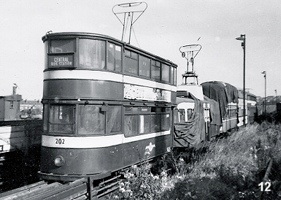Why I Became a Bus Enthusiast or "Buses Galore on Route 54" Part 2
Why I Became a Bus Enthusiast or "Buses Galore on Route 54" Part 2
Not read Part 1 Click here
As we got nearer to the city centre, at Wellington Bridge, we joined Tong Road. Here we saw further Leeds buses, mainly on the former tram routes from Whingate and New Inn, using a mix of Roe or Weymann-bodied AECs and Leylands, as well as routes 42 and 66 which might have one of the new MCW Daimlers in charge.

Kirkstall Road now came in from the left to become Wellington Street and we would now be rejoined by those same West Yorkshire buses we left near Rodley, plus others coming in from Guiseley. More interesting was the appearance of Ledgard buses on their Horsforth or Ilkley via Guiseley routes, probably represented by one of their smart Roe-bodied AEC Regent Vs, or an elderly wartime Daimler (of London Transport or Midland Red origin).

Queen Street, on the left, was the remote terminus for Yorkshire Woollen District's Huddersfield and Halifax services, probably being represented by a Roe PD2, or possibly one of their Guy or PS1 double-deck rebuilds.

We now came to the Wellington Street Coach station, and the sky was the limit for what would be on view. How about one of East Yorkshire's famous Beverley Bar-top PD2 double-deck coaches, or one of their Willowbrook-bodied rear-entrance Tiger Cub coaches, both in their delightful cream and light blue livery on the Hull or Bridlington services.
 The interesting array of coaches operating the Newcastle-Liverpool service and other long-distance routes could include a Northern General Weymann "Fanfare"-bodied Guy, or a Ribble all-Leyland coach, or a West Yorkshire or United Autos' dual-purpose Bristol LS, or perhaps a Yorkshire Woollen District Beadle Commer. This tiny and inadequate facility was often jammed solid on busy weekends, requiring over-spill loading on nearby streets and spare land. Being a holiday Saturday, there would also be numerous coaches belonging to small independent operators, hired for the day.
The interesting array of coaches operating the Newcastle-Liverpool service and other long-distance routes could include a Northern General Weymann "Fanfare"-bodied Guy, or a Ribble all-Leyland coach, or a West Yorkshire or United Autos' dual-purpose Bristol LS, or perhaps a Yorkshire Woollen District Beadle Commer. This tiny and inadequate facility was often jammed solid on busy weekends, requiring over-spill loading on nearby streets and spare land. Being a holiday Saturday, there would also be numerous coaches belonging to small independent operators, hired for the day.
Directly over the road from the coach station was the former LNER railway terminal - Leeds Central. From here, steam engines like the splendid A4 (Mallard)-class departed with all manner of expresses, including Pullman trains, running south to London Kings Cross, or north to Newcastle via Harrogate and Ripon. Presaging times to come, we would also have seen some of BRs early AEC/Park Royal diesel multiple units, used by me on many occasions as alternative transport back to Bramley (on the Bradford route).
However, like many "central" stations, it was not central - being a good walk from the commercial and shopping district, and a very long way from the equally non-central Central Bus Station. Integration between buses and trains was never a strong point in British planning, even in those public transport using days.
Soon after passing King Street, the terminus for Hebble and some of Ledgards routes, we now reached the "hub" of Leeds - City Square - location of the former LMS railway station - Leeds City, with the imposing railway-built Queens Hotel - a much-loved art-deco building.
From here, travellers could take the train to London St Pancras or Carlisle on the former Midland line, or to Manchester via Huddersfield or to Newcastle via York.

Once through the Square, we entered Boar Lane which was an LCT competition-free zone. As this was 1958, we were lucky enough to be joined by the remaining Leeds trams ("Horsfields" and ex-London "Felthams" from the early 1930s) coming up Lower Briggate from Middleton and Belle Isle and joining us to enter the Corn Exchange.
To view a map for 'Route 54' Click here
To read Part 3 Click here
Paul Haywood
02/2010
Photograph captions
7 Leeds City Transport - PUA 653 - 653
1952 AEC Regent III Weymann H58R
Leeds Wholesale Markets 1968
8 Samuel Ledgard - 1954 U
1957 AEC Regent V Roe H65R
Otley 1967 (just after takeover by West Yorkshire)
9 Yorkshire Woollen District - HD7399 - 492
Guy Arab II originally with utility body of 1943 rebodied
by Roe 1953
Dewsbury 1965
10 East Yorkshire Motor Services - MKH 79 - 570
1952 Leyland PD2/12 Roe "Beverley Bar" FH54R
Bridlington 1960
11 Northern General - ECN 688 - 1688
1955 Guy Arab LUF Weymann "Fanfare" C37F
Wellington Street Coach Station 1965
12 Leeds City Transport "Horsfield" tram 202
1931 Brush/LCT
Middleton Railway Preservation Society site Leeds 1961
Comments regarding the above are more than welcome please get in touch via the 'Contact Page' or by email at obp-admin@nwframpton.com
If you have a bus related article that you would like to appear on this site please get in touch via the 'Contact Page' or by email at obp-admin@nwframpton.com
All rights to the design and layout of this website are reserved
Old Bus Photos from Saturday 25th April 2009 to Wednesday 3rd January 2024